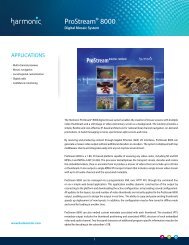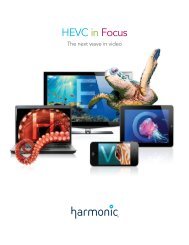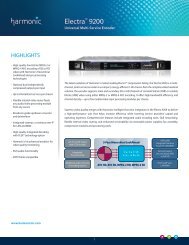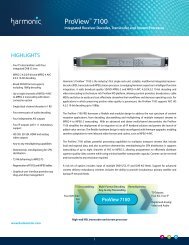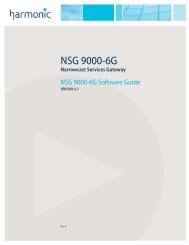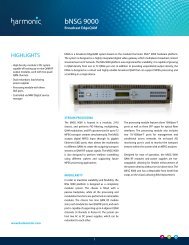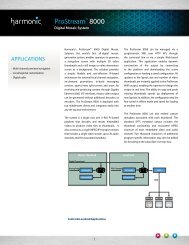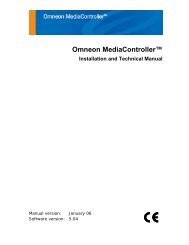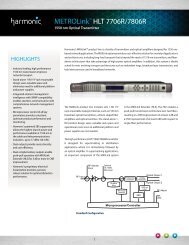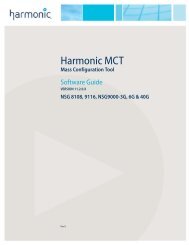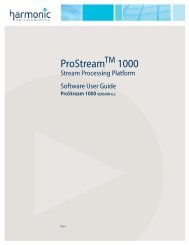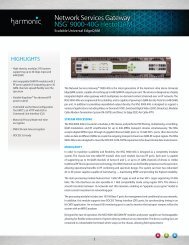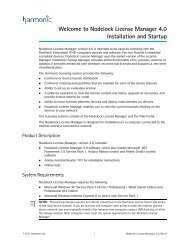Harmonic CLEARcut - Harmonic Inc
Harmonic CLEARcut - Harmonic Inc
Harmonic CLEARcut - Harmonic Inc
You also want an ePaper? Increase the reach of your titles
YUMPU automatically turns print PDFs into web optimized ePapers that Google loves.
Chapter 2<br />
Installation and Setup<br />
This chapter guides you through the steps for setting up the <strong>CLEARcut</strong> Studio system. Which<br />
tasks you perform depend on whether you’re migrating data from one system to another,<br />
upgrading the software on an existing system, or receiving <strong>CLEARcut</strong> for the first time. Refer<br />
to the following table for information about the steps you need to take.<br />
Table 2-1: Installation, Migration, and Upgrade Scenarios<br />
Situation Background Information Relevant Sections in This Chapter<br />
Setting up<br />
<strong>CLEARcut</strong> for the<br />
first time<br />
Migrating data to a<br />
new <strong>CLEARcut</strong><br />
workstation<br />
Upgrading software<br />
on an existing<br />
<strong>CLEARcut</strong><br />
workstation<br />
Adding or<br />
switching encoders<br />
to your <strong>CLEARcut</strong><br />
setup<br />
NMX and <strong>CLEARcut</strong> Studio software is<br />
already installed on the workstation<br />
you received from <strong>Harmonic</strong>. You must<br />
connect and configure the equipment.<br />
NMX and <strong>CLEARcut</strong> Studio software is<br />
already installed on the workstation<br />
you received from <strong>Harmonic</strong>. You must<br />
connect and configure the equipment<br />
and transfer the assets from your old<br />
workstation to the new one.<br />
Back up the <strong>CLEARcut</strong> and NMX<br />
catalogs and assets to another<br />
machine, then perform clean<br />
installation of the entire system, then<br />
restore the catalogs.<br />
Whenever you change the encoders in<br />
your <strong>CLEARcut</strong> setup, you must<br />
connect and configure the equipment.<br />
2.1 Connecting Equipment<br />
■ 2.1 Connecting Equipment on page 12<br />
■ 2.2 Configuring Network Information on<br />
page 14<br />
■ 2.3 NMX Configuration on page 15<br />
■ 2.4.1 Migrating to Another <strong>CLEARcut</strong><br />
Workstation on page 20<br />
■ 2.2 Configuring Network Information on<br />
page 14<br />
■ 2.4 Upgrading <strong>CLEARcut</strong> Studio from a<br />
Previous Version on page 19<br />
■ 2.2 Configuring Network Information on<br />
page 14<br />
■ 2.3.2 Configuring the Encoder in NMX<br />
on page 17<br />
To begin using <strong>CLEARcut</strong> Storage Encoding Solution, first connect the equipment in the<br />
network.<br />
2.1.1 Connecting Source Devices<br />
You can capture streams from video tape players, DVD players, live broadcast sources, or<br />
files on disk (transcoding). Depending on your <strong>CLEARcut</strong> system, you may have multiple<br />
source devices set up.<br />
This section explains how to connect VTRs, VDRs, DVD players, and live source devices. For<br />
instructions for connecting equipment for transcoding (available only on Dell 2RU or IBM<br />
<strong>CLEARcut</strong> platforms), see 2.1.4 Connecting Equipment for Transcoding on page 14.<br />
To connect a VTR, VDR, or DVD player, or live source device:<br />
1. Connect the female end of the provided RS-232-to-RS-422 cable to the COM 1 port on<br />
the <strong>CLEARcut</strong> workstation and the male end to the serial input port on the source device.<br />
© 2011 <strong>Harmonic</strong> <strong>Inc</strong>. 12 <strong>CLEARcut</strong>, Version 3.8, Rev E



